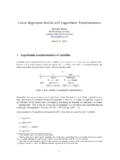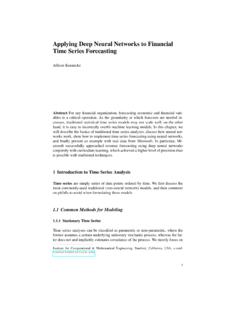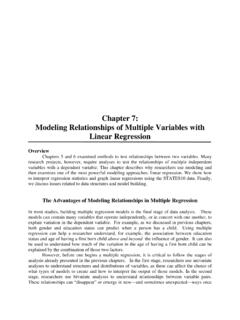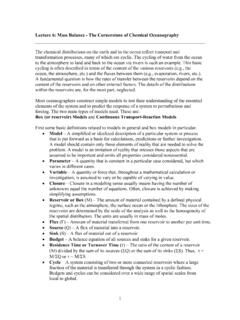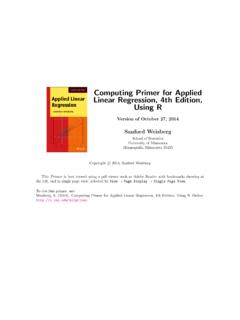Transcription of Linear regression and the normality assumption
1 Linear regression and the normality assumption A F Schmidt* [a] and Chris Finan [a]. a. Institute of Cardiovascular Science, Faculty of Population Health, University College London, London WC1E 6BT, United Kingdom. * Contact: 0044 (0)20 3549 5625. E-mail address: ( ). Word count abstract: 210. Word count text: 2017. Number of references: 13. Number of tables: 0. Number of figures: 3. 1. Abstract Objective Researchers often perform arbitrary outcome transformations to fulfil the normality assumption of a Linear regression model . This manuscript explains and illustrates that in large data settings, such transformations are often unnecessary, and worse, may bias model estimates. Design Linear regression assumptions are illustrated using simulated data and an empirical example on the relation between time since type 2 diabetes diagnosis and glycated haemoglobin (HbA1c).
2 Simulation results were evaluated on coverage; , the number of times the 95% confidence interval included the true slope coefficient. Results While outcome transformations bias point estimates, violations of the normality assumption in Linear regression analyses do not. Instead this normality assumption is necessary to unbiasedly estimate standard errors, and hence confidence intervals and p-values. However, in large sample sizes ( , where the number of observations per variable is larger than 10). violations of this normality assumption do not noticeably impact results. Contrary to this, assumptions on, the parametric model , absence of extreme observations, homoscedasticity and independency of the errors, remain influential even in large sample size settings.
3 Conclusions Given that modern healthcare research typically includes thousands of subjects focussing on the normality assumption is often unnecessary, does not guarantee valid results, and worse more may bias estimates due to the practice of outcome transformations. Keywords Epidemiological methods; Bias; Linear regression ; Assumptions 2. What is new? To ensure the residuals from a Linear regression model follow a normal distribution, researchers often perform arbitrary outcome transformations (here arbitrary should be interpreted as using an unspecified transformation function). These transformations also change the target estimate (the estimand) and hence bias point estimates. Unless these transformations are distributive (in the mathematical sense) in nature inverse transforming model parameters does not necessarily decrease bias.
4 Linear regression models with residuals deviating from the normal distribution often still produce valid results (without performing arbitrary outcome transformations), especially in large sample size settings ( , when there are 10 observations per parameter). Conversely, Linear regression models with normally distributed residuals are not necessarily valid. Graphical tests are described to evaluate the following modelling assumptions on: the parametric model , absence of extreme observations, homoscedasticity and independency of errors. Linear regression models are often robust to assumption violations, and as such logical starting points for many analyses. In the absence of clear prior knowledge, analysts should perform model diagnoses with the intent to detect gross assumption violations, not to optimize fit.
5 Basing model assumption solely on the data under consideration will typically do more harm than good, a prime example of this is the pervasive use of, bias inducing, arbitrarily' outcome transformations. 3. Introduction Linear regression models are often used to explore the relation between a continuous outcome and independent variables; note that binary outcomes may also be used [1,2]. To fulfil the . normality assumption researchers frequently perform arbitrary outcome transformation . For example, using information on more than 100,000 subjects Tyrrel et al 2016[3] explored the relation between height and deprivation using a rank-based inverse normal transformation , or Eppinga et al 2017[4] who explored the effect of metformin on the square root of 233 metabolites.
6 In this paper we argue that outcome transformations change the target estimate and hence bias results. Second, the relevance of the normality assumption is challenged, namely, that non- normally distributed residuals do not impact bias, nor do they (markedly) impact tests in large sample sizes. Instead of focussing on the normality assumption , more consideration should be given to the detection of 1) trends between the residuals and the independent variables, 2). multivariable outlying outcome or predictor values, and 3) general errors in the parametric model . Unlike violations of the normality assumption these issues impact results irrespective of sample size. As an illustrative example the association between years since type 2 diabetes mellitus (T2DM) diagnosis and HbA1c (outcome) is considered [5].
7 Bias due to outcome transformations First, let us define a Linear model and which part of the model the normality assumption pertains to: = 0 + 1 + [ 1]. Here is the continuous outcome variable ( , HbA1c) an independent variable ( , years since T2DM diagnosis), parameter 0 the value when = 0 ( , the intercept term representing the average HbA1c at time of diagnosis), and the errors which are the only part assumed to follow a normal distribution. Often one is interested in estimating 1 ( , the slope). 4. in this example the amount HbA1c changes each year, and the residuals (the observed errors). are a nuisance parameter of little interest. Note that notation represents an estimate of a population quantity such as , and similarly represents an estimate of the (population) average HbA1c.
8 Throughout this manuscript it is assumed that is measured on a scale of clinical interest, for example HbA1c as a percentage, or lipids in mmol/L or mg/dL. In these cases, transforming the outcome to ensure the residuals better approximate a normal distribution often results in a biased estimate of 1 . To see this let's define ( ) as an arbitrary function used to transform the outcome resulting in an effect estimate 1, = ( ) + ( +1 ), with + 1 indicating a unit increase from to + 1 and index for transformed . Clearly 1, cannot equal 1 unless the transformation pertains simple addition ( ) = + (with a constant), hence 1, is a biased 1. estimate of 1 in the sense that 1, . Often one tries to reverse such transformations by applying 1 ( ) on 1, . Such back transformations can only equal 1 when the function ( ) is distributive 1, = ( ) +.
9 ( +1 ) = ( + +1 ); where we assume ( ) + in which case 1, = 1. However, functions most often used for outcome transformations do not have this distributive property and hence the back transformed effect estimate 1 ( 1, ) will not equal 1 . Take for example a logarithmic transformation log10 10 + log10 100 log10 (10 + 100) or the square root transformation 10 + 100 10 + 100. Readers should note that this bias pertains only to arbitrary transformation where the original measurement scale has clinical relevance (and is not normally represented on the transformed 5. scale), and not to the general use of the logarithmic scale (or any other mathematical functions). as an outcome. For example, the acidity of a solution is typically indicated by the pH (potential of hydrogen) which is best understood on the logarithmic scale.
10 Similarly, this type of bias is only relevant in so far one is interested in interpreting 1 , if for example one is concerned with prognostication, outcome transformations are less of an issue. Furthermore, hypothesis tests from Linear regression models using arbitrary transformed outcomes are still valid. However, as stated before, in using Linear regression models we assume researchers are interesting in estimating the magnitude of an association. If, instead, a researcher is interested in testing a (null-) hypothesis non-parametric methods will often be more appropriate. The normality assumption in large sample size settings We define large sample size as a setting where the observations are larger than the number of . parameters one is interested in estimating.










